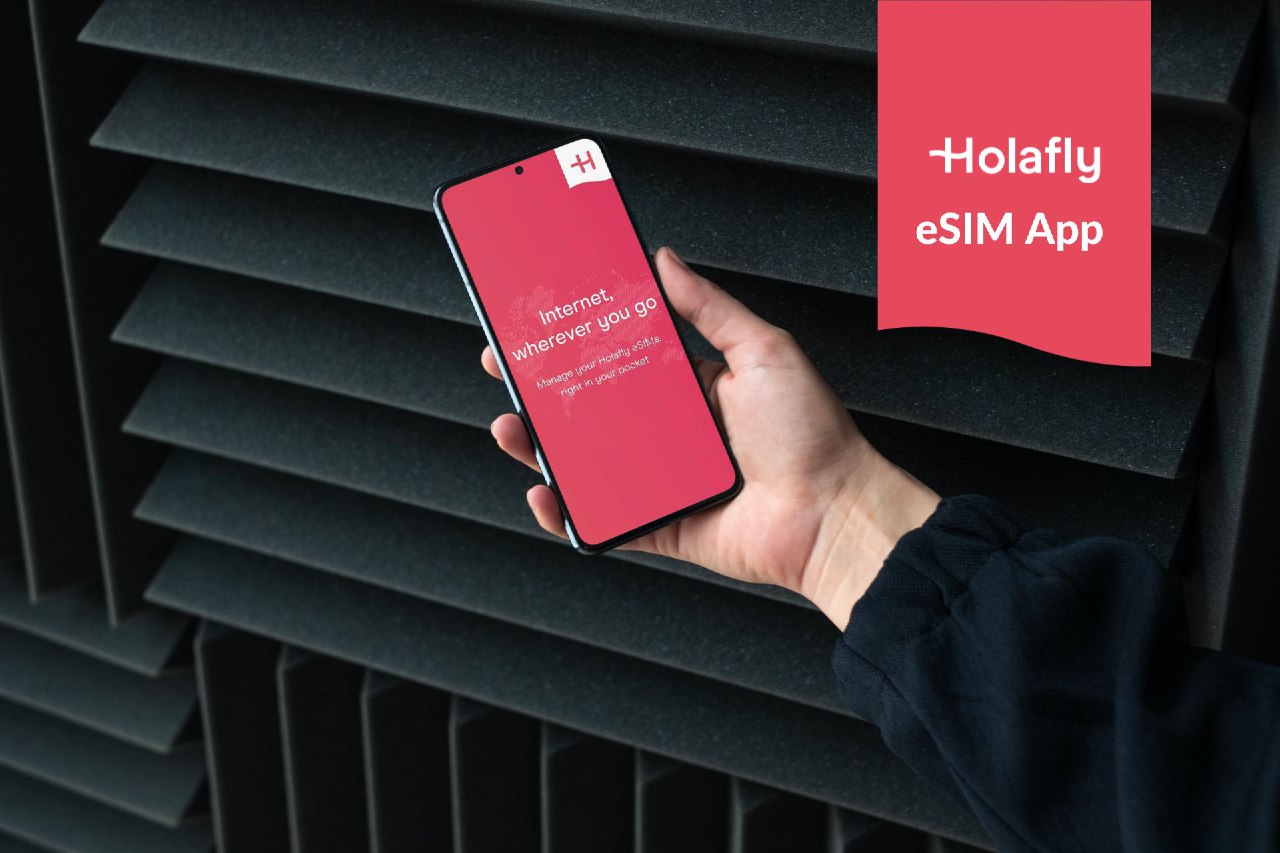eSIM integrated devices
Get to know about the eSIM compatible devices and how they integrate into our everyday lives for a more connected world.
From the smartphones we carry to the automobiles we drive and the IoT devices that create our world, eSIM technology has invaded practically every facet of our linked existence. Integration will be a breeze, which should make staying connected easier, increase productivity, and bring in a new era of technical advancement. As more and more devices adopt eSIMs, the potential for a hyper-connected future is limitless, and the world is poised to stay connected like never before.
The advent of embedded SIM (eSIM) technology has revolutionized the connectivity landscape. This has reshaped the way various devices access and manage cellular networks. Let’s explore the integration of eSIMs in smartphones, laptops, wearables, IoT devices, automobiles, and more. While we’re at it, we’ll highlight their influence on user experience, convenience, and the broader technological ecosystem. Through a comprehensive analysis, we uncover the transformative potential and challenges associated with eSIM technology in different applications and devices.



 +1M
+1M
With Holafly, you save +30% compared to roaming fees
Plans that may interest you
Evolution of eSIM Technology
The concept of eSIM technology can be traced back to the early 2010s at GSMA. At this time, it emerged as a solution to simplify device activation and connectivity. It has developed over time from a niche innovation to a mainstream technology. Even major device manufacturers around the world are embracing key milestones, including the standardization efforts of industry bodies and the introduction of eSIM-compatible devices. The GSMA is the international group that works to improve conditions by discovering, developing, and distributing innovations fundamental to the mobile ecosystem. Their goal is to liberate the full potential of connectivity for the benefit of individuals, businesses, and communities. (en el párrafo anterior o en el siguiente se puede enlazar al post sobre la evolución de la eSIM que tenemos en el blog)
GSMA launched the first digital SIM in 2015 (Source: GMSA – Our history), promising the future of communication. The purpose was to make activation, remote provisioning, and carrier switching simpler. This eSIM technology was first implemented on smartphones, but it has since spread to other devices. Such devices are tablets, wearables, laptops, and IoT gadgets, allowing for constant connectivity and streamlining everyday life, travel, and even industry. For example, over-the-air software updates and real-time navigation are just two examples of how eSIMs have revolutionized the car industry recently. This flexible technology has also helped the environment by cutting down on discarded plastic chips.
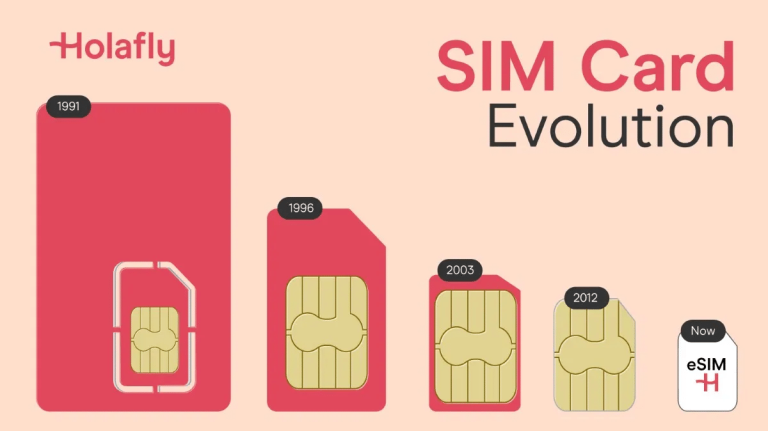
Technical Underpinnings
At its core, eSIM technology and compatible devices rely on a programmable SIM card integrated directly into the device’s hardware.
Unlike traditional SIM cards, eSIMs are rewritable and can be provisioned remotely, enabling users to switch carriers or activate new plans without the need for a physical card swap. Security features, such as remote deactivation in case of theft, make eSIMs a robust choice for modern devices.
Compatibility Across Devices
Smartphones
First, we’ll talk about how eSIMs are used on the most popular devices: mobile phones. The likes of Apple, Google, and Samsung have all jumped on the eSIM bandwagon, giving customers a less complicated and more adaptable method of handling their cellular connections. To activate a new plan or switch carriers, all it takes is a few clicks on your handset with an eSIM. If you are eager to know more about all the smartphones compatible with the eSIM, have a look at our eSIM-compatible phones list!
The first phone to incorporate the eSIM was the Google Pixel 2 and soon after, manufacturers followed suit. Apple launched the eSIM iPhone 14 in September 2022 with only eSIM capabilities, eliminating the SIM card slot. The iPhone 15, launched on September 12th, is confirmed as a SIM card slot-less new flagship phone. Look at the full list of cellphones that are compatible with the eSIM.
Wearables
Due in large part to eSIM technology, smartwatches and other wearables are now fully functional standalone devices. Digital SIMs enable these gadgets to communicate with cellular networks independently of a smartphone. Those who value physical activity and minimal baggage will appreciate this newfound independence. Is your smartwatch compatible with the eSIM? Find out now!
It’s difficult to pinpoint exactly how many smartwatches are currently eSIM compatible. However, according to research firm Counterpoint Research, (estos enlaces externos se pueden marcar para abrirse en una nueva pestaña) by the year 2030 100% of smartwatches will be completely compatible with the virtual SIM. Research has led to conclude that the eSIM growth has reached an inflection point and is now set for hyper-growth in the coming years.
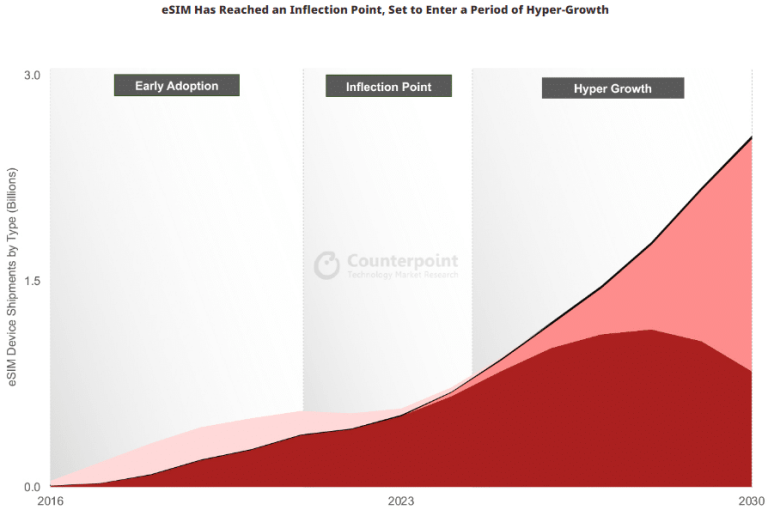
Portable Devices: Constantly Connected and Highly Effective
Virtual SIMs are now widely available for use on mobile devices such as laptops (enlazar a los ordenadores con eSIM) and tablets. You can be in a cafe on the other side of the planet with your laptop instantly and connected to a local data plan. The first eSIM-compatible device in terms of tablets was Microsoft’s Surface Pro LTE. They launched this device in 2017 and ever since, other laptop and tablet developers have also integrated the digital SIM for easier access to the internet. This is especially useful for those who must remain connected to work and for digital nomads.
Automotive Industry
The automotive industry has witnessed a significant transformation with the integration of eSIMs. Modern vehicles are becoming more connected, offering features like real-time navigation, remote diagnostics, and over-the-air software updates. Notable automakers, including Tesla and BMW, have embraced eSIM technology to enhance the driving experience.
The automotive industry is a big opportunity for carriers and providers like Holafly. In 2022, the entire connected car market size was evaluated at around USD $33.73 billion. Predictions estimate that in 2032, the market will reach USD $136.11 billion. Check out the Precedence Research chart below for more insight.
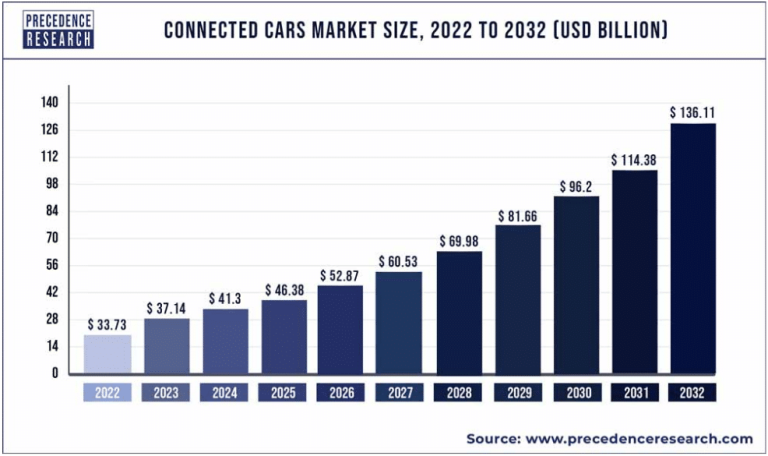
In terms of numbers, in 2021, Insider Intelligence estimated that in 2025 more than 70% of licensed drivers will be using a connected car in the US. This represents more than 166 million cars just in one country! This is an important resource because as the eSIM market and applications expand, so do business opportunities.

IoT Devices
Defined by Amazon as the interconnected network of electronic gadgets and the underlying technology that allows them to talk to one other and the cloud, the “Internet of Things”. The proliferation of IoT can also be attributed to the eSIM. Smart meters, connected automobiles, and industrial sensors may now wirelessly transport data to and from the cloud with ease and security. Optimized and continuous connectivity that drives device performance for mission-critical applications can be guaranteed thanks to eSIMs. This allows them to function across many networks. Machine-to-machine connections through eSIMs are also warranted by GSMA (eSIM Specification M2M).
According to IoT Analytics, the eSIM/iSIM market share in 2023 is 32%. This surpasses the traditional SIM card which is currently at 27%.
Background
Just to give you a little background on the current trends and status of IoT. We have found that there are currently over 16.7 billion connected devices, with a forecast of more than 29 billion in 2027, according to the latest spring IoT Analytics report.
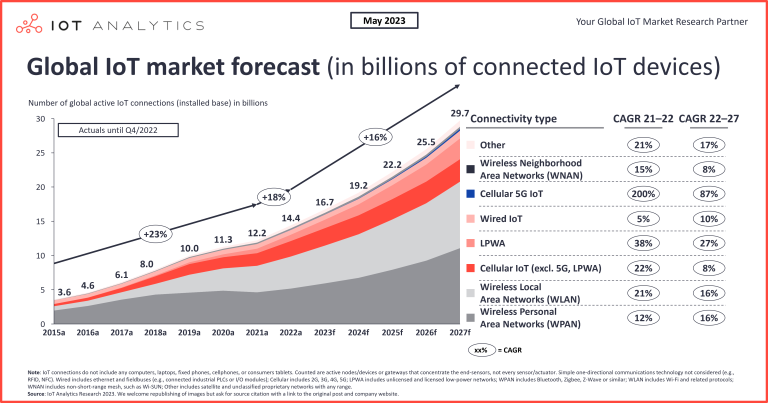
Taking a more in-depth look, we found that a slowing economy has led to a decline in demand, which in turn, has improved the chipset supply chain. Fueled by the USA and EU chip acts of 2022, leading in to a bright future for the IoT-eISM industry. This is an important aspect because this can improve accessibility for companies to implement an eSIM integration strategy into production or automatization. Thus, leading to higher profits and growth.
Agriculture Applications
In the agriculture industry, eSIM technology is revolutionizing connectivity for Internet of Things equipment. There are a number of ways that eSIMs can be used in the agricultural sector. In precision farming, for instance, eSIM-enabled sensors and machinery collect data in real time on things like soil conditions, weather, and crop health, and then transfer that data to farmers’ mobile devices or cloud storage. By using this information, farmers may optimize water, fertilizer, and pesticide usage, so maximizing crop yields while minimizing waste. Equipment downtime and maintenance expenses can be cut with the use of eSIMs because they allow for remote monitoring. Because of their ability to switch between networks, eSIMs are critical to the modernization of agriculture in remote locations with spotty coverage.
Shipping and Logistics
Internet of Things (IoT) devices and networks are essential to the efficiency and quality of life gains that characterize smart cities. The use of eSIMs is critical to the smooth operation of these gadgets. With eSIM-enabled sensors in traffic lights and cameras, for instance, information may be transmitted to command centers, improving traffic flow and lowering congestion. Trash cans equipped with eSIMs that report when they are full help streamline collection schedules and cut down on overhead expenses. Additionally, eSIMs enable smart meters for utilities, allowing locals to keep tabs on their own energy and water usage in real time and pitch in to conservation initiatives. With eSIM technology, these Internet of Things gadgets can safely maintain their connections while they travel across the city or switch between networks.
Smart Cities
Continuous connectivity for tracking and monitoring assets is being made possible by eSIMs, which is causing a revolution in the transportation and logistics business. For instance, eSIMs are a significant improvement for tracking containers. Small SIM cards placed in shipping containers allow for constant monitoring of their location, temperature, and security status. In addition to lessening the possibility of loss or damage, this boosts supply chain visibility, which in turn facilitates more efficient route optimization, shorter wait times, and lower total costs. In addition, eSIMs facilitate international internet connectivity, which enables transportation and logistics firms to follow their assets across international borders with ease. This is becoming more vital in a sector where goods can go across numerous regions and countries in a single trip. When it comes to improving shipping and logistics sector efficiency, security, and transparency, eSIMs are a game-changer.
User Experience and Convenience
Simplified Connectivity
One of the most significant advantages of eSIMs is the simplified connectivity they offer. Users can switch carriers or activate new plans with ease, enhancing flexibility and reducing the complexity of managing multiple physical SIM cards. Travelers greatly benefit from eSIMs, as they can access local data plans in foreign countries without the hassle of acquiring and inserting physical SIM cards.
Seamless Transition
The transition from traditional SIM cards to eSIMs has been remarkably smooth for consumers. Manufacturers have implemented user-friendly interfaces to facilitate eSIM activation and management. User feedback indicates high levels of satisfaction with the convenience and flexibility offered by eSIM technology.
Improved Mobility
For frequent travelers and digital nomads, constantly swapping SIM cards to stay connected can be inefficient and disruptive. A reliable, flexible solution is ideal for users traveling across multiple destinations. Some eSIM providers, like Holafly, offer both short-term prepaid plans and global monthly eSIM subscriptions. These options ensure uninterrupted access to data without changing providers or dealing with paperwork and legal requirements.
Challenges, Opportunities and the Road Ahead
Security and Privacy Concerns
While eSIMs offer numerous benefits, they also raise security and privacy concerns. Securing remote provisioning capabilities is crucial to avoid exploitation. Ensuring robust encryption and authentication protocols is crucial to mitigating these risks. Addressing privacy issues related to remote tracking and monitoring is also important. We consider cybersecurity is one of the most relevant factors to continue developing trust in the eSIM.
Market Adoption and Standardization
The adoption of eSIM technology varies across regions and industries. Ongoing efforts in standardization and interoperability are essential to encouraging widespread adoption. Industry collaborations and adherence to global standards will facilitate seamless eSIM integration across devices. Thanks to GSMA, they provide global standardization specifications for the eSIM this leads companies and manufacturers to have a guide on how to design their own compatible products.
Consumer Awareness
Finally, consumer awareness is another important aspect that will drive the eSIM market, not only for consumers but for enterprises. With both carrier and manufacturer push, the IoT eSIM market is headed for healthy growth. GSMA predicts that by 2023, there will be a total of 37.4 billion IoT connections globally.
>>Download the full document here<<





 Language
Language 


















 No results found
No results found



